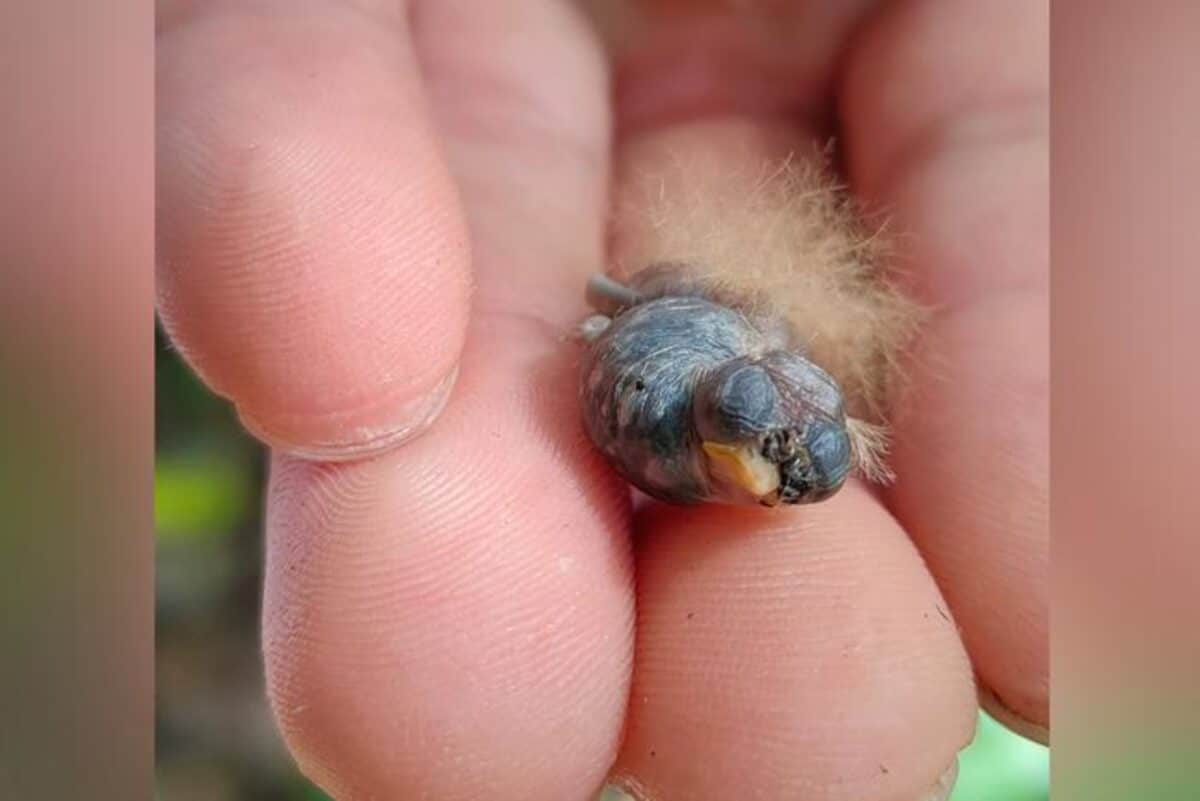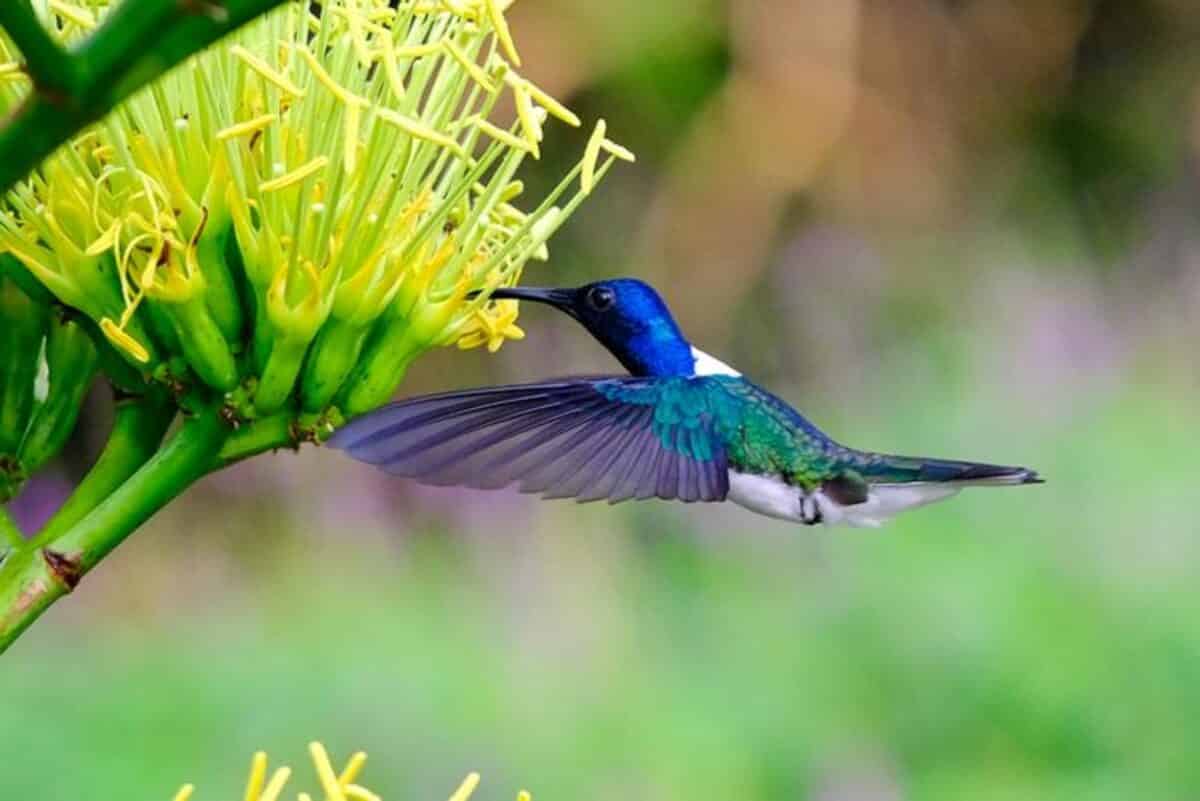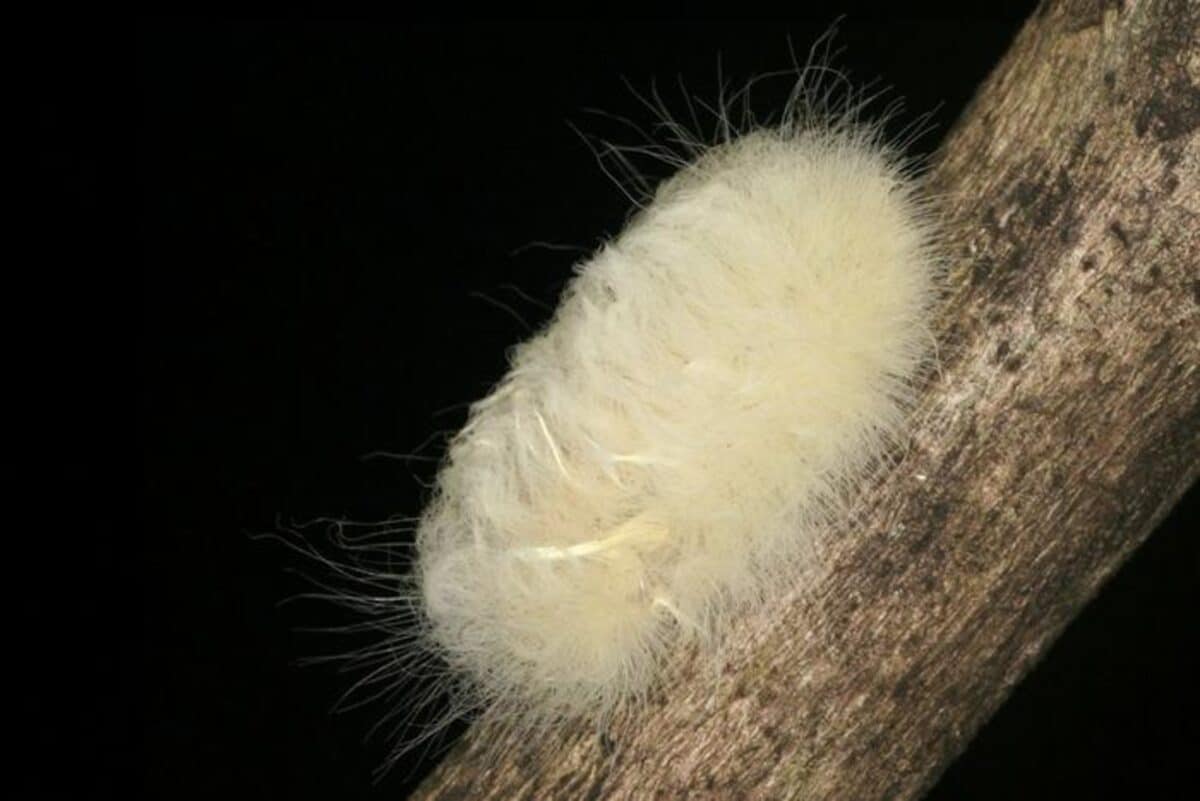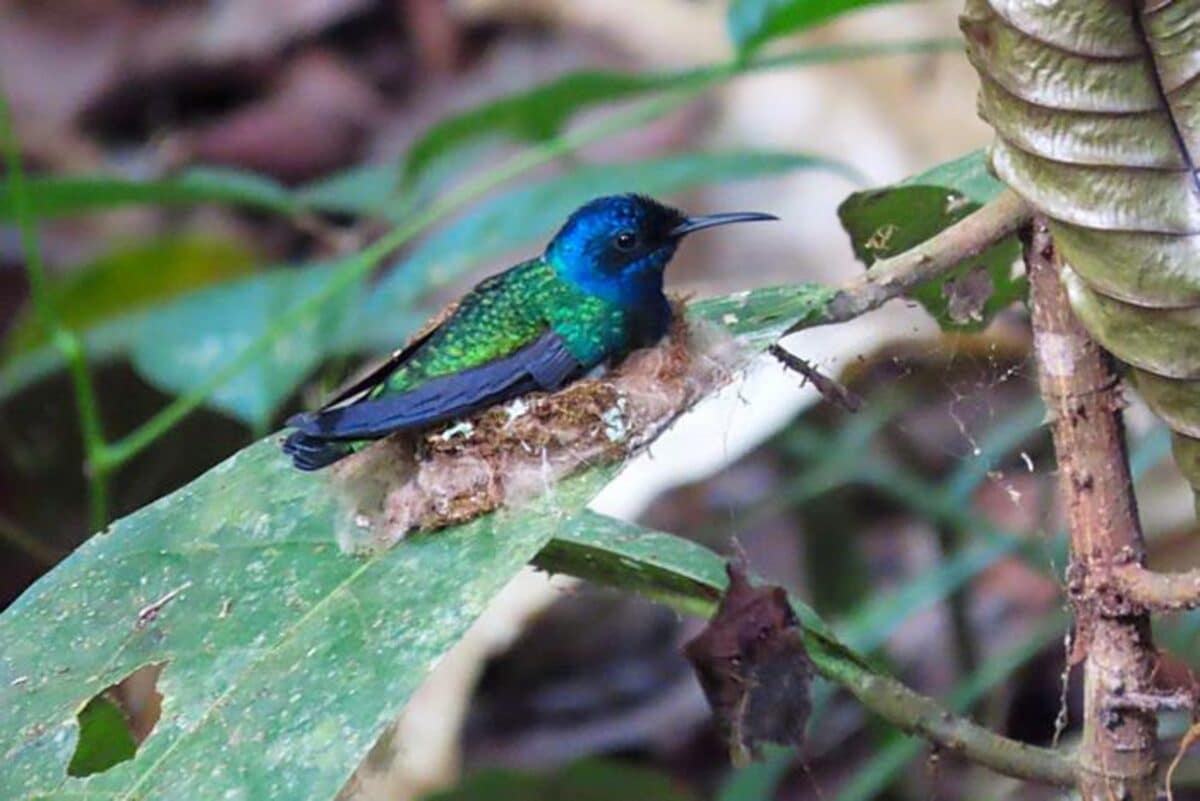
Newly hatched White-necked Jacobin chick. Notice its dorsal fluffy down feathers. (Credit: Michael Castaño-Díaz)
In a nutshell
- Newly hatched white-necked jacobins are covered in fuzzy down and shake their heads like venomous caterpillars—potentially tricking predators into staying away.
- If confirmed, it would be one of the few known examples of Batesian mimicry in birds, a strategy more commonly seen in insects and reptiles.
- Despite decades of hummingbird research, this behavior had never been observed before—highlighting how much is still unknown about tropical wildlife.
PANAMA CITY — Deep in Panama’s lush forests, something unexpected unfolds that’s changing how scientists think about bird defenses. A baby white-necked jacobin hummingbird, just hatched and utterly vulnerable, doesn’t act like your typical baby bird. Instead of gaping its mouth and chirping for food when disturbed, it does something extraordinary and pretends to be something else entirely.
Scientists recently discovered that these hummingbird chicks are covered in unusually long, fuzzy down feathers and shake their heads from side to side when threatened. This bizarre behavior isn’t random; it makes them look remarkably like toxic, stinging caterpillars that many predators avoid.
Researchers from various universities and the Smithsonian Tropical Research Institute documented this fascinating behavior in a recent paper published in Ecology. Their observations point to a case of Batesian mimicry, where a harmless species evolves to look like a dangerous one. This is something rarely seen in birds.
A Baby Bird Acts Like a Caterpillar

Lukas Hummel)
“Some science discoveries take years. Others just take one curious observation, and having the right people in the right place,” says study author Jay Falk from the Smithsonian Tropical Research Institute and the University of Colorado, in a statement.
The discovery began when Smithsonian Tropical Research Institute researchers found a white-necked jacobin nest with a caring female and one egg on Plantation Road, a trail within Soberanía National Park in Panama. They enlisted videographer Joe See to help document events. This was the first white-necked jacobin nest the team had ever seen.
Around 18-20 days later, the researchers visited the nest accompanied by Scott Taylor, Jay’s advisor at the University of Colorado. The egg had hatched, and Taylor noticed something unusual: long, fluffy down feathers on the chick’s back that made it look strikingly similar to a caterpillar.
The chick’s appearance wasn’t the only surprise. Rather than begging for food when approached, it would rear its head upward and shake it side-to-side about once per second, while the long feathers stood on end.
This behavior proved effective in the wild. On March 12, while the mother was away, researchers observed a carnivorous paper wasp approaching the nest. The day-old chick responded with its head-shaking movement, after which the wasp, a potential predator, flew away.
A Rare Defense Strategy in the Bird World

Many caterpillars in the region have specialized hairs that can cause painful skin reactions, inflammation, and even headaches, nausea, and fever in humans when touched. By resembling these hazardous caterpillars, the hummingbird chick might be fooling potential predators into staying away.
Young animals often face extreme vulnerability to predation, especially in tropical regions. For hummingbirds, which are tiny and typically raised by a single parent, the risks are even greater. Studies have found extremely low nesting success rates in some hummingbird species, with predation being the main culprit.
When researchers compared the white-necked jacobin to other hummingbird species, they found most had little to no natal down (the feathers they are born with). Only white-necked jacobins and their close relatives, black jacobins, showed the combination of open cup nests and extensive fuzzy down that creates the caterpillar-like appearance.

Michael Castaño-Díaz)
Interestingly, Falk had previously discovered that approximately 20% of females in this species look like males, probably to increase access to food, and this chick’s mother was one of them. This makes the new discovery about chick appearance even more fascinating, suggesting multiple unusual adaptations within this species.
Beyond Mimicry: Other Possible Explanations
The researchers considered alternative explanations for the unusual appearance and behavior. They noticed the nest was covered with what appeared to be seeds of local Balsa trees which are also hairy-looking, making the chick well-camouflaged.
The long down feathers might help the chick blend in with the nest material. They could also serve as a physical barrier against smaller predators or help regulate temperature. However, neither of these alternatives fully explains the distinctive head-shaking behavior that so closely resembles what caterpillars do when threatened.

This is one of the few known cases of potential Batesian mimicry in birds. A comparable example is the Cinereous Mourner, a bird native to South America known for its caterpillar-like chicks that also display similar defensive movements.
Unfortunately, the researchers couldn’t continue observations after March 23rd because the chick died (though without apparent physical damage) and the female abandoned the area.
Nature’s Hidden Surprises
The white-necked jacobin’s strategy appears to have evolved independently in this genus. While many tropical hummingbirds nest under leaves or in other concealed locations, both white-necked and black jacobins build open cup nests on top of large leaves in the forest understory.
Tropical forests contain countless mysteries and discoveries waiting to be made. Nature conceals remarkable survival strategies, sometimes right in front of our eyes. In the complex life-or-death ecosystem of tropical forests, a defenseless baby bird’s best strategy might simply be to pretend to be something else entirely.
Paper Summary
Methodology
The research team observed a white-necked jacobin nest in Panama’s La Soberanía National Park from February to March 2024. They photographed and filmed the chick’s appearance and behavior, particularly its responses to potential threats. To determine how unusual this trait might be, they compared their observations with photos of other hummingbird species on ebird.org, examining closely related species to establish evolutionary context.
Results
The study documented newly hatched white-necked jacobin chicks have unusual amounts of long natal down feathers, creating a fuzzy appearance similar to caterpillars with irritating hairs. When disturbed, chicks perform a distinct side-to-side head-shaking motion at about one movement per second—remarkably similar to the defensive thrashing of caterpillars. This behavior successfully deterred a predatory paper wasp during observation. Only white-necked jacobins and their close relatives showed this combination of extensive natal down and exposed nesting locations.
Limitations
The observations come from just one nest with a single chick, making it difficult to generalize across the entire species. The observation period was relatively short and ended when the chick died for unknown reasons. While the researchers documented a wasp being deterred after the chick’s display, they couldn’t conclusively prove this was specifically due to mimicry rather than other factors. Without controlled experiments testing predator responses, the mimicry hypothesis remains compelling but not definitively proven.
Discussion and Takeaways
This discovery suggests Batesian mimicry might be more widespread in birds than previously thought. It helps explain why some hummingbirds might use seemingly vulnerable nesting strategies—they’ve evolved compensatory defenses. The finding raises questions about evolutionary trade-offs, suggesting there must be some cost to having extensive natal down since most related species lack it. The research demonstrates that even well-studied animals like hummingbirds still have undiscovered aspects of their biology, particularly in tropical ecosystems.
Funding and Disclosures
This research was funded by the U.S. National Science Foundation through a Postdoctoral Research Fellowship in Biology (Grant 2209192) awarded to Jay J. Falk. The Ministry of Environment in Panama provided permits (ARB-076-2023, ARB-025-2023) for observations in protected parklands. The authors declared no conflicts of interest related to this study.
Publication Information
The study “Potential caterpillar mimicry in a tropical hummingbird” was published in Ecology (Volume 106, Issue 3, article number e70060) on March 17, 2025. The research was conducted by Jay J. Falk, Michael Castaño-Diaz, Sebastian Gallan-Giraldo, Joseph See, and Scott Taylor from the University of Colorado, the Smithsonian Tropical Research Institute, the University of Wyoming, and the University of Antioquia.







